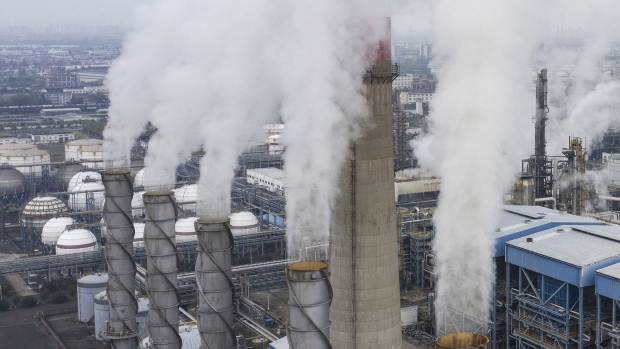

Exhaust rises from smoke stacks at the Sinopec Zhenhai Refining & Chemical Co. processing facility in this aerial photograph taken on the outskirts of Ningbo, Zhejiang Province, China, on Wednesday, April 22, 2020. China’s top leaders softened their tone on the importance of reaching specific growth targets this year during the latest Politburo meeting on April 17, saying the nation is facing “unprecedented” economic difficulty and signaling that more stimulus was in the works. Photographer: Qilai Shen/Bloomberg , Photographer: Qilai Shen/Bloomberg
The Association of Southeast Asian Nations is seeking to establish a framework for green investments in the region that could be worth as much as $3 trillion.
The countries set up the Asean Taxonomy board this week, which will develop and maintain a set of categories and definitions to guide its members on sustainable economic activities, according to a statement on Tuesday. The region is joining Europe in devising benchmarks for green investments to meet the targets of the Paris Agreement.
As global pressure mounts to drastically cut carbon output to stave off climate change, governments and corporations are shifting attention toward renewable power and lowering emissions. The move by Asean, a region heavily reliant on coal, is key to establishing clarity and common definitions necessary for markets to know what constitutes “green” investing.
“While the Asean Taxonomy recognizes international aspirations and goals, it will take into consideration the region’s unique needs and as such will be beneficial to all Asean member states,” the board said in the statement. “It will be designed to ensure that Asean member states have a framework that suits their economic and social structures that other frameworks will not be able to address.”
Setting clear rules would help the region of 650 million people to capture green financing opportunities that could be worth $3 trillion between 2016 and 2030, according to a report by Asean Working Committee on Capital Markets Development. The group of 10 countries is equivalent to the world’s fifth largest-economy with a diverse demographic that has gross domestic product per capita ranging from $1,441 to $64,567.
The Asean Taxonomy board plans to design a tiered framework where its members and the different financial segments could adopt what are appropriate for them, according to the statement. The regulatory infrastructure will initially focus on decarbonization and incorporate other sustainability aspects in future.
The inaugural board comprises eight members including representatives from Monetary Authority of Singapore, Bank Negara Malaysia and Bank of Thailand. It’s chaired by Noorrafidah Sulaiman, a deputy managing director at Autoriti Monetari Brunei Darussalam. Daniel Wang, an executive director at MAS, is the vice chairman.
The board, overseen by the Asean Finance Ministers and Central Bank Governors’ Meeting and hosted by the Sustainable Finance Institute Asia, will include members from more Asean countries later. The board plans to announce its progress by the end of this year.
View: Source
View: More news



